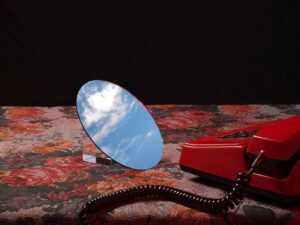A new show at the Huis Marseille, Amsterdam, considers how photographers have adapted to the age of Instagram. Infinite Identities: Photography in the Age of Sharing asks important questions: how has social media allowed artists to explore issues of identity, society, politics and the definition of the art object? The work included in the show runs a gamut of forms and subjects, from Myriam Boulos’s searing images of life in Beirut following the Summer 2020 explosion to the satirical performance art of Martine Gutierrez; from Santi Palacios’s photo-documentary shots of migrants crossing the Mediterranean to Thomas Lohr’s stylish, unsettling scenes of urban alienation. Aesthetica speaks to the show’s curator, Nanda van den Berg.
A: Social media platforms such as Instagram have made photography a central part of our daily lives. What are the artistic possibilities of this and how are they explored in this show?
NVB: This show is about interaction between digital and physical space. There is an enormous amount of potential here, and many different approaches are possible. In fact, the eight participating artists each have a different relationship with their Instagram account. Important for this show in particular is that I “found” the participating artists on Instagram and followed them, then invited them to exhibit an autonomous installation in the museum, which led to eight different installations. Infinite Identities points to all the new energy and possibilities that are added to their art practice through these new media. We have only scratched the surface so far, but it is pretty inspiring already.
A: You have assembled a truly international cast of artists. Was this a conscious decision?
NVB: Some three years ago I started using Instagram and started realising that here was a new tool for photography and a new photographic narrative and iconography was being developed through the ephemerality of the medium. Whilst exploring this subject, my concept progressed and I found artists who used the app in an innovative way, connecting it with their art practice. For the show I just selected artists that I follow on Instagram. It is undoubtedly an international medium: you can go wherever your ever-expanding network takes you (aided by the algorithmic recommendations) which is everywhere.
A: Many of the photographers deal with global political events and themes, such as the August 2020 explosion in Beirut and migrants attempting to reach Europe by boat. What do you feel is significant about artists using social media to represent these events and themes?
NVB: Through following artists on their stories where they post these images, you are immediately involved in what is happening. There is no delay, no filter, no news site necessary. As a follower you “live” these events with them on the spot. That is a very important aspect – I think – to make you feel the urgency of these subjects.
A: Do you see the work in this show as speaking to older art or photography movements (Pop Art, Performance Art)?
NVB: Definitely. There is even a screengrab from the artist Chloë Wise where she addresses the subject of Andy Warhol. Martine Gutierrez – a participating artist in the show – is a performance artist. Frida Orupabo is an artist who shows sculptures and collages. Santi Palacios is a photo-journalist, and so forth. This is a subject that merits a much longer answer!
A: Have the artists in the show used the common tools available on social media (such as photo filters and the Instagram Stories format) to alter or encode the message of their work?
NVB: In the museum galleries, no, as we are looking at actual photography there, but the context of Instagram is evoked in the hallways and landings by series of screengrabs made from Instagram stories that are very informative and engaging, and say a lot about the represented artists and the times we live in. Nick Sethi is the one artist who adds a layer of meaning to his work by using filters; in his case, the work that we are showing is very close to his actual Instagram Stories feed, which fits the concept of the show perfectly.
A: In your introduction to the book accompanying this exhibition, you talk about how your concept for the show was altered by COVID-19 and your subsequent reliance on digital technology. Can you tell us about this?
NVB: I completely had to rethink the way and the means to make the exhibition. The “old-fashioned” way to work with an artist is to invite them to come over to the museum and explore possibilities together on the basis of the room(s) you have in mind for their work. The experience of the physical space and the bond you build with the artist during this process is important. The dialogue is inspiring and leads to new approaches. During COVID, artists could not travel anymore. Our first conversations took place on Zoom, the majority of them never saw the actual spaces, we needed to work with sketch-ups and floorplans, and so on.
A: What do you find most exciting about the show?
NVB: I am particularly excited by the fact that all the work presented is very new and current and very “now.” The exhibition is in step with the times in which we live. It’s life elevated to the gallery: sourced via Instagram and placed in the installations in our rooms.
Until 28 February. Find out more here.
Words: Greg Thomas
Lead image: Sub-saharan migrants wait to be rescued by aid workers of Spanish NGO Open Arms in the Mediterranean Sea on Tuesday, July 25, 2017. © Santi Palacios.





